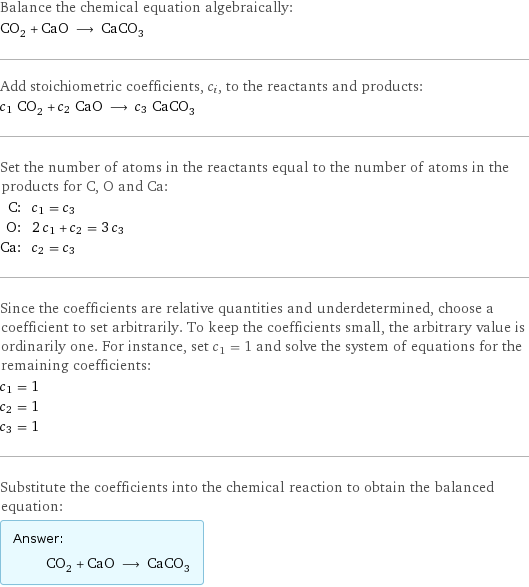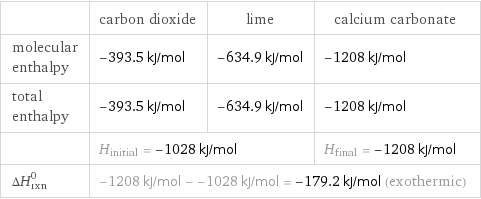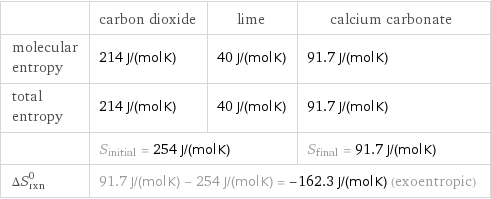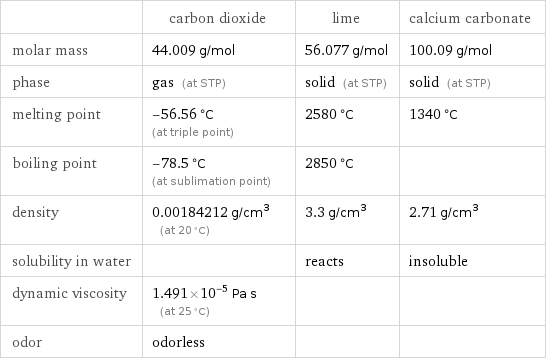Input interpretation

CO_2 (carbon dioxide) + CaO (lime) ⟶ CaCO_3 (calcium carbonate)
Balanced equation

Balance the chemical equation algebraically: CO_2 + CaO ⟶ CaCO_3 Add stoichiometric coefficients, c_i, to the reactants and products: c_1 CO_2 + c_2 CaO ⟶ c_3 CaCO_3 Set the number of atoms in the reactants equal to the number of atoms in the products for C, O and Ca: C: | c_1 = c_3 O: | 2 c_1 + c_2 = 3 c_3 Ca: | c_2 = c_3 Since the coefficients are relative quantities and underdetermined, choose a coefficient to set arbitrarily. To keep the coefficients small, the arbitrary value is ordinarily one. For instance, set c_1 = 1 and solve the system of equations for the remaining coefficients: c_1 = 1 c_2 = 1 c_3 = 1 Substitute the coefficients into the chemical reaction to obtain the balanced equation: Answer: | | CO_2 + CaO ⟶ CaCO_3
Structures

+ ⟶
Names

carbon dioxide + lime ⟶ calcium carbonate
Reaction thermodynamics
Enthalpy

| carbon dioxide | lime | calcium carbonate molecular enthalpy | -393.5 kJ/mol | -634.9 kJ/mol | -1208 kJ/mol total enthalpy | -393.5 kJ/mol | -634.9 kJ/mol | -1208 kJ/mol | H_initial = -1028 kJ/mol | | H_final = -1208 kJ/mol ΔH_rxn^0 | -1208 kJ/mol - -1028 kJ/mol = -179.2 kJ/mol (exothermic) | |
Gibbs free energy

| carbon dioxide | lime | calcium carbonate molecular free energy | -394.4 kJ/mol | -603.3 kJ/mol | -1129 kJ/mol total free energy | -394.4 kJ/mol | -603.3 kJ/mol | -1129 kJ/mol | G_initial = -997.7 kJ/mol | | G_final = -1129 kJ/mol ΔG_rxn^0 | -1129 kJ/mol - -997.7 kJ/mol = -131.4 kJ/mol (exergonic) | |
Entropy

| carbon dioxide | lime | calcium carbonate molecular entropy | 214 J/(mol K) | 40 J/(mol K) | 91.7 J/(mol K) total entropy | 214 J/(mol K) | 40 J/(mol K) | 91.7 J/(mol K) | S_initial = 254 J/(mol K) | | S_final = 91.7 J/(mol K) ΔS_rxn^0 | 91.7 J/(mol K) - 254 J/(mol K) = -162.3 J/(mol K) (exoentropic) | |
Equilibrium constant
![Construct the equilibrium constant, K, expression for: CO_2 + CaO ⟶ CaCO_3 Plan: • Balance the chemical equation. • Determine the stoichiometric numbers. • Assemble the activity expression for each chemical species. • Use the activity expressions to build the equilibrium constant expression. Write the balanced chemical equation: CO_2 + CaO ⟶ CaCO_3 Assign stoichiometric numbers, ν_i, using the stoichiometric coefficients, c_i, from the balanced chemical equation in the following manner: ν_i = -c_i for reactants and ν_i = c_i for products: chemical species | c_i | ν_i CO_2 | 1 | -1 CaO | 1 | -1 CaCO_3 | 1 | 1 Assemble the activity expressions accounting for the state of matter and ν_i: chemical species | c_i | ν_i | activity expression CO_2 | 1 | -1 | ([CO2])^(-1) CaO | 1 | -1 | ([CaO])^(-1) CaCO_3 | 1 | 1 | [CaCO3] The equilibrium constant symbol in the concentration basis is: K_c Mulitply the activity expressions to arrive at the K_c expression: Answer: | | K_c = ([CO2])^(-1) ([CaO])^(-1) [CaCO3] = ([CaCO3])/([CO2] [CaO])](../image_source/4289845bfc094326fdc307a6c9691329.png)
Construct the equilibrium constant, K, expression for: CO_2 + CaO ⟶ CaCO_3 Plan: • Balance the chemical equation. • Determine the stoichiometric numbers. • Assemble the activity expression for each chemical species. • Use the activity expressions to build the equilibrium constant expression. Write the balanced chemical equation: CO_2 + CaO ⟶ CaCO_3 Assign stoichiometric numbers, ν_i, using the stoichiometric coefficients, c_i, from the balanced chemical equation in the following manner: ν_i = -c_i for reactants and ν_i = c_i for products: chemical species | c_i | ν_i CO_2 | 1 | -1 CaO | 1 | -1 CaCO_3 | 1 | 1 Assemble the activity expressions accounting for the state of matter and ν_i: chemical species | c_i | ν_i | activity expression CO_2 | 1 | -1 | ([CO2])^(-1) CaO | 1 | -1 | ([CaO])^(-1) CaCO_3 | 1 | 1 | [CaCO3] The equilibrium constant symbol in the concentration basis is: K_c Mulitply the activity expressions to arrive at the K_c expression: Answer: | | K_c = ([CO2])^(-1) ([CaO])^(-1) [CaCO3] = ([CaCO3])/([CO2] [CaO])
Rate of reaction
![Construct the rate of reaction expression for: CO_2 + CaO ⟶ CaCO_3 Plan: • Balance the chemical equation. • Determine the stoichiometric numbers. • Assemble the rate term for each chemical species. • Write the rate of reaction expression. Write the balanced chemical equation: CO_2 + CaO ⟶ CaCO_3 Assign stoichiometric numbers, ν_i, using the stoichiometric coefficients, c_i, from the balanced chemical equation in the following manner: ν_i = -c_i for reactants and ν_i = c_i for products: chemical species | c_i | ν_i CO_2 | 1 | -1 CaO | 1 | -1 CaCO_3 | 1 | 1 The rate term for each chemical species, B_i, is 1/ν_i(Δ[B_i])/(Δt) where [B_i] is the amount concentration and t is time: chemical species | c_i | ν_i | rate term CO_2 | 1 | -1 | -(Δ[CO2])/(Δt) CaO | 1 | -1 | -(Δ[CaO])/(Δt) CaCO_3 | 1 | 1 | (Δ[CaCO3])/(Δt) (for infinitesimal rate of change, replace Δ with d) Set the rate terms equal to each other to arrive at the rate expression: Answer: | | rate = -(Δ[CO2])/(Δt) = -(Δ[CaO])/(Δt) = (Δ[CaCO3])/(Δt) (assuming constant volume and no accumulation of intermediates or side products)](../image_source/94fca819e4f5b62ff213292807173732.png)
Construct the rate of reaction expression for: CO_2 + CaO ⟶ CaCO_3 Plan: • Balance the chemical equation. • Determine the stoichiometric numbers. • Assemble the rate term for each chemical species. • Write the rate of reaction expression. Write the balanced chemical equation: CO_2 + CaO ⟶ CaCO_3 Assign stoichiometric numbers, ν_i, using the stoichiometric coefficients, c_i, from the balanced chemical equation in the following manner: ν_i = -c_i for reactants and ν_i = c_i for products: chemical species | c_i | ν_i CO_2 | 1 | -1 CaO | 1 | -1 CaCO_3 | 1 | 1 The rate term for each chemical species, B_i, is 1/ν_i(Δ[B_i])/(Δt) where [B_i] is the amount concentration and t is time: chemical species | c_i | ν_i | rate term CO_2 | 1 | -1 | -(Δ[CO2])/(Δt) CaO | 1 | -1 | -(Δ[CaO])/(Δt) CaCO_3 | 1 | 1 | (Δ[CaCO3])/(Δt) (for infinitesimal rate of change, replace Δ with d) Set the rate terms equal to each other to arrive at the rate expression: Answer: | | rate = -(Δ[CO2])/(Δt) = -(Δ[CaO])/(Δt) = (Δ[CaCO3])/(Δt) (assuming constant volume and no accumulation of intermediates or side products)
Chemical names and formulas

| carbon dioxide | lime | calcium carbonate formula | CO_2 | CaO | CaCO_3 Hill formula | CO_2 | CaO | CCaO_3 name | carbon dioxide | lime | calcium carbonate
Substance properties

| carbon dioxide | lime | calcium carbonate molar mass | 44.009 g/mol | 56.077 g/mol | 100.09 g/mol phase | gas (at STP) | solid (at STP) | solid (at STP) melting point | -56.56 °C (at triple point) | 2580 °C | 1340 °C boiling point | -78.5 °C (at sublimation point) | 2850 °C | density | 0.00184212 g/cm^3 (at 20 °C) | 3.3 g/cm^3 | 2.71 g/cm^3 solubility in water | | reacts | insoluble dynamic viscosity | 1.491×10^-5 Pa s (at 25 °C) | | odor | odorless | |
Units
